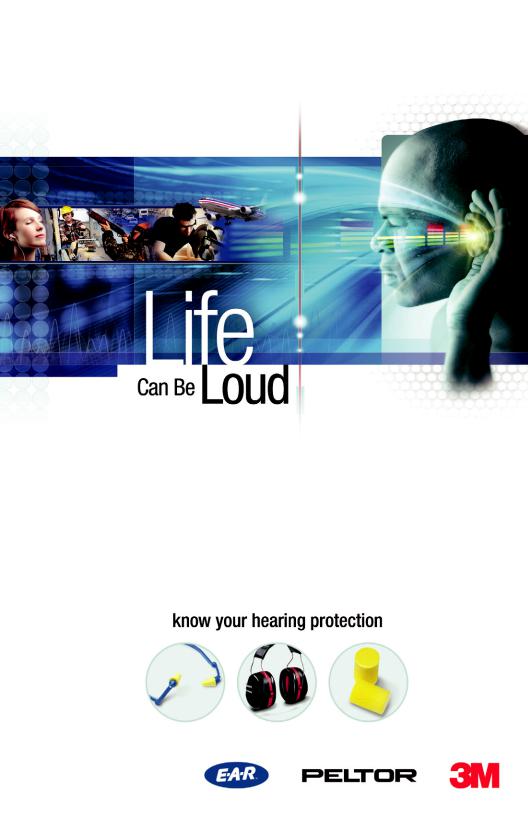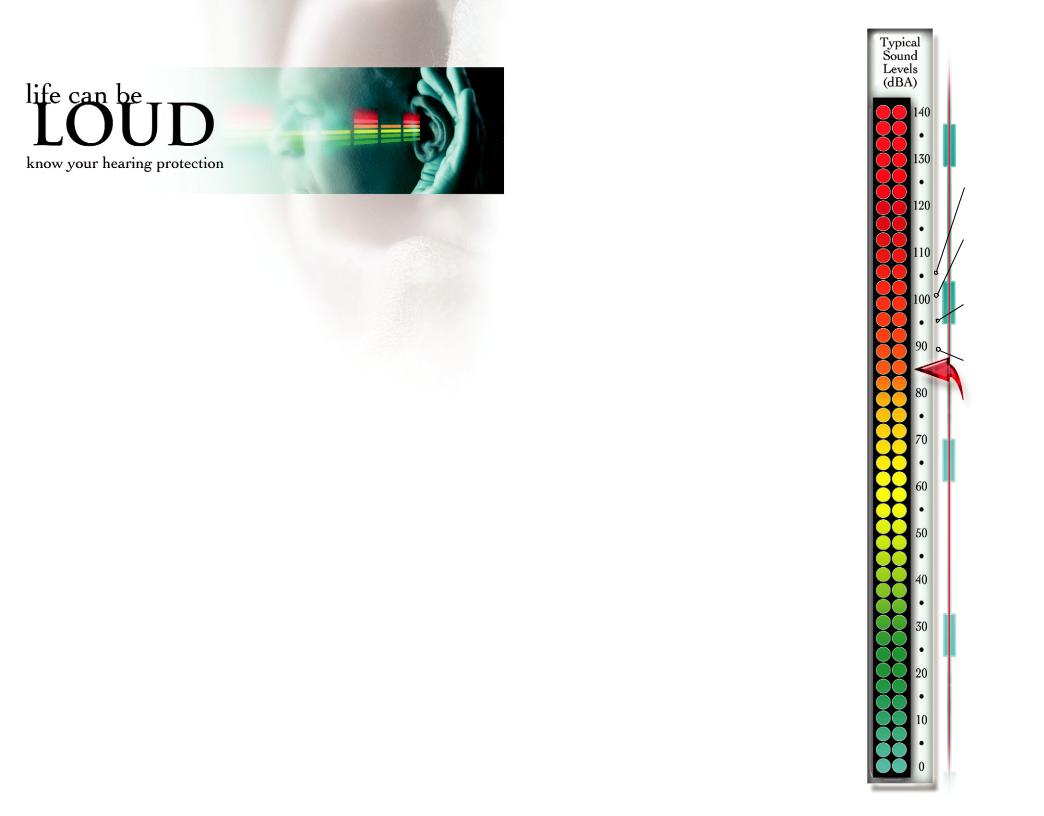3M 340-3002, P1400, P1401, H10A, H6F/V User Manual
...

The Sound Around Us
Noise is everywhere. It is the most pervasive environmental pollutant on the planet. Virtually everything we do makes noise, and the more we do it, the faster we do it, and the more of us there are - the more noise is made. In fact, silence, by which we mean complete absolute quiet, is so rare that few of us have had the joy, or perhaps even the possibility to experience it. If we have, it is so unusual that we can likely cite the time and place of its last occurrence. The opportunities to savor such tranquility are rapidly vanishing.
Not only is noise present in our daily routines and recreational activities, but upwards of 5 million Americans, possibly as many as 30 million, work in
hazardous noise on a daily basis. Estimates from the National Institutes of Health suggest that hearing loss afflicts 28 million Americans. About 1/3 of those cases are at least partially attributable to noise. Later in this booklet we’ll tell you how the ear works and how noise can affect it, so you will understand why you should protect your ears from too much sound today in order for your hearing to serve you tomorrow.
In a world as noisy as ours we frequently tune out. Moreover, our culture is so visually dominant that often sight overwhelms the other senses such as audition (the hearing of sounds), which is habitually relegated to second-class status. The purpose of this pamphlet is to address these issues – to increase your appreciation and awareness of the sounds around you and to provide some tools to help you protect yourselves from loud, annoying and/or hazardous sound.
Measuring Noise
Noise hazard depends on the level |
|
|
(sometimes called intensity) of the noise, |
|
|
its duration, and how often the exposure |
|
|
occurs. The point above which regular |
|
|
exposure to sounds becomes hazardous is |
|
|
a level of about 85 decibels (abbreviated |
|
|
dB, or sometimes dBA which is the value |
Jet Takeoff |
|
that more closely corresponds to human |
||
hearing). Noise is measured using a sound |
|
|
level meter. |
Basketball |
|
|
||
You Don’t Get “Used to Noise” |
Game |
|
Crowd Noise |
||
Noise does not have to be uncomfortably |
Large |
|
loud, or even painful, to be damaging. You |
Stamping |
|
may think your ears are “used to the noise,” |
Press |
|
but what has probably happened is that |
Chain Saw |
|
your hearing has been temporarily dulled |
||
|
||
or that hearing loss has already begun. |
|
A Rule of Thumb
When you feel the need to shout in order to be heard three feet away, the noise levels are probably 85 dBA or more and hearing protectors are recommended.
Using Your Ears to Assess Noise Risk
If, after the noise stops, you notice a ringing, buzzing, or whistling in your ears that wasn’t there before, this is a warning indicator.
Called tinnitus, this is like a “sunburn” of the nerve cells of your inner ear,
indicating that they have been irritated and overworked. Tinnitus is especially noticeable in a quiet place, such as when you are trying to go to sleep at night. If you don’t protect your ears from noise, tinnitus can become a permanent, constant annoyance in your life.
Apparent muffling or softening of sounds after noise exposure is a warning sign that your hearing is affected by a temporary threshold shift. Repeatedly exposing your ears without protection can cause the shift to worsen and become permanent, resulting in untreatable damage to your hearing ability.
Drilling Concrete
Leaf Blower
Vacuum
Cleaner
Inside Mid-
Size Auto
(65 mph)
Conversation
Floor Fan
Quiet Library
Rice Krispies
Watch
Ticking
Quiet
Wilderness
(no wind)
Pain threshold
Dual protection may be needed
Short exposures can cause permanent hearing loss
Prolonged exposure causes moderate to severe loss. Wear hearing protectors with extra care
Prolonged exposure causes mild to moderate loss. Hearing protectors required
Prolonged exposure causes slight hearing loss. Hearing protectors recommended
Residential boundary-noise limit
Sleep disruption may begin
Threshold of
Hearing

Hearing Protection
Hearing loss due to noise is almost entirely preventable by judicious use of hearing protection. To find what is best for you, try different devices from the wide variety available today. Be sure to carefully read the instructions because hearing protectors must fit properly and be worn correctly to do the job. Hearing protector effectiveness is specified by a Noise Reduction Rating (NRR), typically ranging from 15 35 decibels. In practice the protection that normally can be achieved is about 10 20 decibels. The more carefully you fit and wear hearing protectors, the higher your protection will be. Hearing protectors may feel uncomfortable at first, but give yourself a chance to get used to them, just as you do with a new pair of shoes or glasses.
Foam plugs, made from expandable slow-recovery foam, provide the best combination of comfort and protection for most users. They must be properly prepared for insertion. One size fits most. Once in the ear, foam plugs expand to provide a snug and secure custom fit. The two most common complaints about foam plugs (“not enough protection,” and “they don’t stay in”) are almost always solved by greater practice and care in insertion.
Premolded plugs are made from flexible materials that are preformed to fit the ear. They are generally available with a joining cord to prevent loss. Although the version pictured at the left is a one-sized product, many premolded plugs are sold in two or more sizes
and must be individually sized for each ear. If after a period of regular wear you’ve been unable to get used to your earplugs, try another size, type, or brand of hearing protector.
Earplug Fitting Tip
Press firmly cupped hands over your ears while listening to a steady noise. With properly fitted plugs the noise levels should be about the same whether or not the ears are covered.
How Much Protection
Don’t get hung up on the NRR, the government-mandated noise protection factor that appears on all hearing protector packaging. The numbers are based on optimized laboratory tests that, in practice, represent what only a few of the most-motivated best-trained users can achieve. Your best bet is to use the NRR only as an indicator that a product was designed and tested for noise reduction. Except for very loud noises such as gunfire where selection is more critical, most hearing protectors provide sufficient protection when worn properly and consistently. Foam plugs or earmuffs, or a combination of the two generally provide the highest levels of protection.
Slowly roll and compress foam plugs into a very thin crease-free cylinder. While compressed, insert plug well into the earcanal.
Fitting is easier if you reach around the head to pull the ear outward and upward during insertion.
Reach around the back of your head and pull outward and upward on the ear while inserting the plug until you feel it sealing.
This may seem tight at first, especially if you’ve never worn earplugs.
Carefully twist the plug to break the seal for a slow, safe removal.
Keep the plugs clean and free from material that can irritate the earcanal. They may be washed in mild liquid detergent and warm water. Squeeze excess water from the plugs and allow to fully
air dry. Washing may be repeated several times. Discard plugs if they noticeably change their firmness or
do not re-expand to their original size and shape.
Premolded plugs will normally last several months or more depending upon the type, and environmental factors. They should be replaced if they
shrink or swell, harden or soften, tear, crack, or become permanently deformed.
Wash them in warm soapy water and rinse well. When dry, store them in a carrying case.
